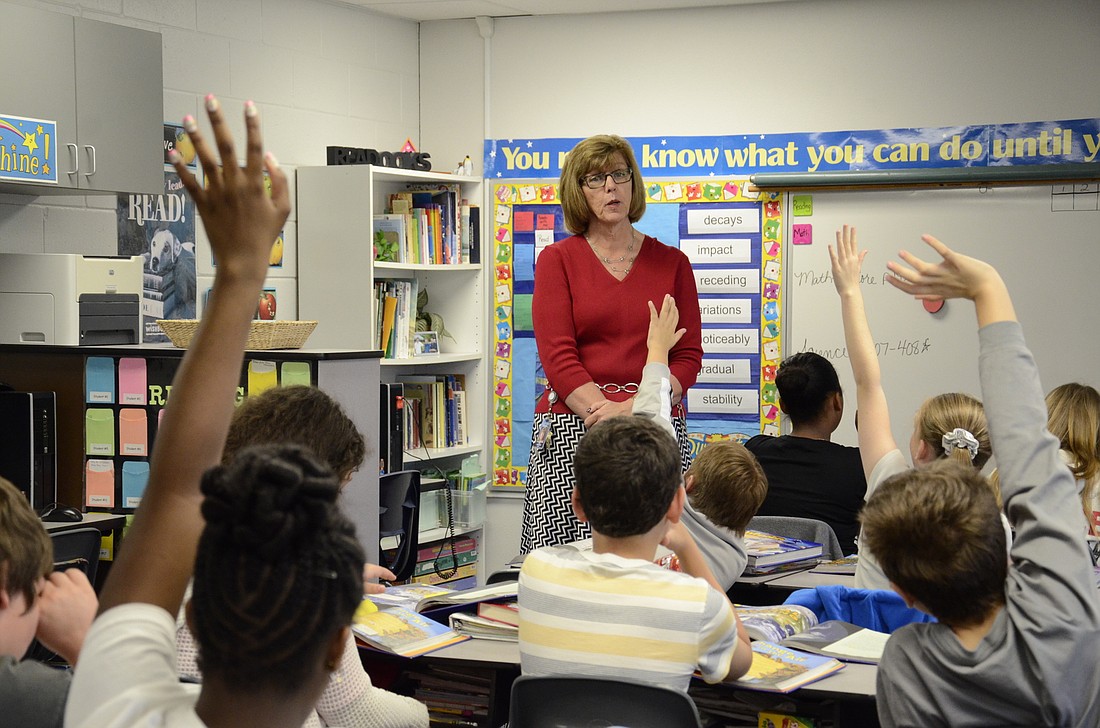- April 25, 2024
-
-
Loading

Loading

Bay Haven School of Basics-Plus fifth-grade teacher Jane Wiechmann, 58, said her retirement in June will be bittersweet.
She’ll miss the classroom — being a teacher has been her identity for 35 years — but she’s glad to have more time for volunteering and traveling. Most of all, however, she’ll miss working with the students and families at Bay Haven, where she’s taught since 1988.
“It’s so exciting to see that light bulb when they learn,” she said.
Wiechmann is one of many employees who entered the state Deferred Retirement Option Program (DROP) in 2010. Once enrolled in the program, employees must retire after five years.
“Those five years fly by,” she said.
Wiechmann is not alone: Sarasota County Schools will have more than 100 vacancies by the end of the school year (not all of the positions are DROP employees) — 5% of its teaching staff. In the 2013-2014 school year, there were 82.
However, Wiechmann said getting a fresh batch of new teachers could have a positive effect: The students are of the digital era, and younger incoming teachers understand how to apply that to the classroom.
“With all the new technology, those teachers are great,” Wiechmann said.
The Sarasota County School Board bumped up its budgeting calendar to focus on staffing issues at its March 17 workshop. Sarasota County government — which is facing a similar challenge — is also trying to plan ahead.
Within the next five years, approximately one-third of county employees will be eligible for retirement — about 600 people. Not all of them will retire right away, but the county has already started planning for their departure.
Currently, the county sees a 5% annual retirement rate from its workforce, or about 100 people a year. Approximately 20 of those retirees leave their positions because of the DROP requirement, although, in 2014, 40 retired due to DROP, and 40 will retire in 2016, as well. The countywide workforce — including the public and private sectors — has a median age of 46, according to data collected by Sarasota County Openly Plans for Excellence (SCOPE). That’s more than three years older than the state median age of 42.7 and the national median of 42.3.
However, Joanie Whitley, Sarasota County government human resources director, said the age of Sarasota County government employees has actually decreased — it used to be 50.
The average age of the county government’s 2,200 employees is 47.5; the average length of employment is 10.4 years.
One of the county’s biggest challenges is competing with the private sector for potential new employees because it can usually offer more money.
“Other companies and governments are looking for employees. It’s getting competitive out there.”
– County Administrator Tom Harmer
The county is undergoing a market study to gauge where its wages and salaries fall in the job marketplace, Whitley said. Harmer said that after the recession, the county was unable to give employees raises until 2013, when the county paid employees a lump sum; in 2014, employees were given a pay increase based on merit.
When hiring new employees, Harmer said, the county must be careful to be fair to current employees. It’s a tough balance: whether to tempt a potential employee with a higher salary at the risk of offending a tenured employee in the same position who makes less money.
In anticipation of the loss of what Harmer called “institutional knowledge” — the experience of the pool of employees who have worked for the county for years and know how it functions — the county is in a succession-planning process to allow new employees to train with the exiting retiree, when possible.
“With so many retirements on the horizon, we’re taking advantage of overlap,” Whitley said. “Directors have to think ahead.”
One source of potential employees the county has tapped is graduating high school students. Mike Suarez, former emergency services director and now a part-time county employee, has worked with the county for more than 30 years. He assists the county in diversity hiring, but also visits the county’s high schools to educate students about opportunities in local government.
While the county seeks local students, Sarasota County Schools gets most of its new hires from the upper Midwest.
Sarasota Schools Human Resources Director Roy Sprinkle said the district has been doing extensive recruiting efforts, such as job fairs, especially in the middle of the country. It’s a strategic move.
“(In the Midwest), there are lots of schools and not lots of jobs,” he said.
Sprinkle said demand for teachers is high throughout the state as other districts are experiencing the same high retirement rates.
“We’re all trying to get them,” he said. “It’s a problem.”
However, for Sarasota, tempting new teachers isn’t a hard sell. Sprinkle said the district boasts the highest average salary in the state at $58,000 and the second highest for starting salaries at $42,608, as well as high performance ratings. The district has maintained an “A” rating on the state’s annual grading scale since 2004, and in the 2013-2014 school year, Sarasota County’s district was ranked the second-highest on the state’s grading list.
“Teachers want to teach where academics are valued,” Sprinkle said. “When we recruit, we get a lot of attention.”
In the meantime, the positions are filled with qualified substitutes, but the district needs additional teachers for a growing student population — current enrollment is 42,360 and it’s projected to increase by 938 students this fall. Now that the economy is on the rebound, more families are moving into the district, he said.
A recruitment team from the district is visiting Indiana this month to attempt to attract new teachers for local positions.
“Every time they have a bad winter, we get a few more,” he said.